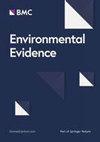Evidence of anticipatory forest use behaviours under policy introduction: a systematic map protocol
IF 5.2
4区 环境科学与生态学
Q2 ENVIRONMENTAL SCIENCES
引用次数: 0
Abstract
Abstract Background Forest conservation is a major global policy goal, due to the role forests play in climate change mitigation and biodiversity conservation. It is well recognized that the introduction of policies, whether aimed at forest conservation or with other objectives, has the potential to trigger unintended outcomes, such as displacement or leakage, which can undermine policy objectives. However, a set of outcomes that has escaped detailed scrutiny are anticipatory forest use behaviours, emerging when forest stakeholders anticipate policy implementation, deploying for example pre-emptive forest clearing, resulting in detrimental environmental outcomes. Lack of understanding of the extent and sectorial scope of these behaviours prevents us from devising strategies to address their potential detrimental consequences. Methods This protocol presents the methodology that will be followed to conduct a systematic map to identify, compile, review and describe the evidence available on anticipatory forest use behaviours in the context of policy introduction around the world. We will use two complementary search strategies, which we have tested before submitting this protocol. First, a systematic bibliographic search, and second, a citation chase approach. We will include articles based on a pre-defined set of criteria defined according to a Population, Intervention and Outcome (i.e. PIO) design. To support identification of knowledge gaps and clusters, we will report results of the systematic map in a narrative synthesis, an evidence atlas and other visualisations.政策引入下预期森林利用行为的证据:系统地图协议
摘要背景森林在减缓气候变化和保护生物多样性方面发挥着重要作用,因此森林保护是一项重要的全球政策目标。大家都认识到,无论是以保护森林为目的还是以其他目标为目的的政策,都有可能引发意想不到的结果,例如流离失所或泄漏,从而破坏政策目标。然而,一组未被详细审查的结果是预期性森林利用行为,当森林利益相关者预期政策实施时出现,例如部署先发制人的森林砍伐,导致有害的环境后果。缺乏对这些行为的程度和部门范围的了解,使我们无法制定战略来解决其潜在的有害后果。方法本议定书提出了将遵循的方法,以进行系统的地图,以确定、汇编、审查和描述在世界各地政策引入背景下有关预期森林利用行为的现有证据。我们将使用两种互补的搜索策略,在提交此协议之前我们已经对其进行了测试。首先是系统的书目检索,其次是引文追踪方法。我们将纳入根据人口、干预和结果(即PIO)设计定义的一套预先定义的标准的文章。为了支持识别知识差距和集群,我们将以叙事综合、证据地图集和其他可视化方式报告系统地图的结果。
本文章由计算机程序翻译,如有差异,请以英文原文为准。
求助全文
约1分钟内获得全文
求助全文
来源期刊

Environmental Evidence
Environmental Science-Management, Monitoring, Policy and Law
CiteScore
6.10
自引率
18.20%
发文量
36
审稿时长
17 weeks
期刊介绍:
Environmental Evidence is the journal of the Collaboration for Environmental Evidence (CEE). The Journal facilitates rapid publication of evidence syntheses, in the form of Systematic Reviews and Maps conducted to CEE Guidelines and Standards. We focus on the effectiveness of environmental management interventions and the impact of human activities on the environment. Our scope covers all forms of environmental management and human impacts and therefore spans the natural and social sciences. Subjects include water security, agriculture, food security, forestry, fisheries, natural resource management, biodiversity conservation, climate change, ecosystem services, pollution, invasive species, environment and human wellbeing, sustainable energy use, soil management, environmental legislation, environmental education.
 求助内容:
求助内容: 应助结果提醒方式:
应助结果提醒方式:


